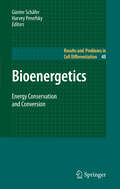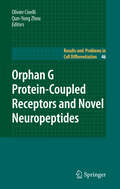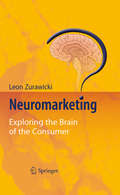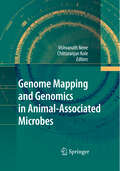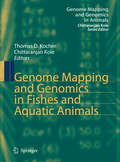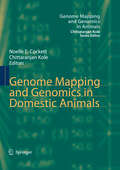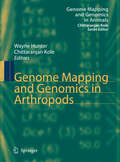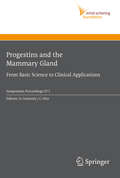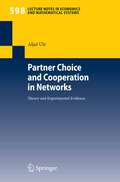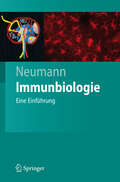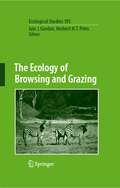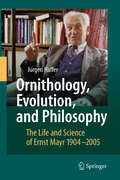- Table View
- List View
The Buzz about Bees: Biology of a Superorganism
by Jürgen TautzTis book, already translated into ten languages, may at frst sight appear to be just about honeybees and their biology. It c- tains, however, a number of deeper messages related to some of the most basic and important principles of modern biology. Te bees are merely the actors that take us into the realm of phys- ology, genetics, reproduction, biophysics and learning, and that introduce us to the principles of natural selection underlying the evolution of simple to complex life forms. Te book destroys the cute notion of bees as anthropomorphic icons of busy self-sacr -i fcing individuals and presents us with the reality of the colony as an integrated and independent being—a “superorganism”—with its own, almost eerie, emergent group intelligence. We are s- prised to learn that no single bee, from queen through drone to sterile worker, has the oversight or control over the colony. - stead, through a network of integrated control systems and fee- backs, and communication between individuals, the colony - rives at consensus decisions from the bottom up through a type of “swarm intelligence”. Indeed, there are remarkable parallels between the functional organization of a swarming honeybee colony and vertebrate brains.
Orientation and Navigation in Vertebrates
by Andrii RozhokThis book reviews all major models and hypotheses concerning the mechanisms supposed to underlie the process of navigation in vertebrates. It covers data on all major model groups of vertebrates studied in the context of animal navigation, such as migratory birds, homing pigeons, sea turtles, subterranean mammals and some migratory fish species. Some other – less studied – groups, e.g., whales, have also been touched. The first part of the book describes different sources of navigational information, with their specific navigational mechanisms known or supposed to be employed by animals for navigational goals. The second part discusses possible functions of these mechanisms in different vertebrates and in the context of different navigational tasks, ranging from short-range navigation, often performed by animals within as small an area as several square meters, to long-distance global-scale migrations performed by many birds and some sea turtles during their lifespan.
Bioenergetics: Energy Conservation and Conversion (Results and Problems in Cell Differentiation #45)
by Günter Schäfer Harvey PenefskyThe fermentation of sugar by cell-free yeast extracts was demonstrated more than a century ago by E. Buchner (Nobel Prize 1907). Buchner’s observations put an end to previous animistic theories regarding cellular life. It became clear that metabolism and all cellular functions should be accessible to explication in chemical terms. Equally important for an understanding of living systems was the concept, explained in physical terms, that all living things could be cons- ered as energy converters [E. Schrödinger (Nobel Prize 1933)] which generate complexity at the expense of an increase in entropy in their environment. Bioenergetics was established as an essential branch of the biochemical sciences by the investigations into the chemistry of photosynthesis in i- lated plant organelles [O. Warburg (Nobel Prize 1931)] and by the discovery that mitochondria were the morphological equivalent that catalyzed cellular respiration. The ?eld of bioenergetics also encompasses a large variety of ad- tional processes such as the molecular mechanisms of muscle contraction, the structure and driving mechanisms of microbial ?agellar motors, the energetics of solute transport, the extrusion of macromolecules across membranes, the transformation of quanta of light into visual information and the maintenance of complex synaptic communications. There are many other examples which, in most cases, may perform secondary energy transformations, utilizing - ergy stored either in the cellular ATP pool or in electrochemical membrane potentials.
Orphan G Protein-Coupled Receptors and Novel Neuropeptides (Results and Problems in Cell Differentiation #46)
by Olivier Civelli Qun-Yong ZhouOver the last decade it has been shown that orphan G protein-coupled receptors (GPCRs) can be used as targets to discover novel neuropeptides. A dozen neuropeptides have been identified through this approach. Each of these neuropeptides has opened new doors for our understanding of fundamental physiological or behavioral responses. For example the orexins, MCH and ghrelin carry fundamental roles in regulating food intake while neuropeptide S, neuromedin S, the prokineticins and the orexins are major players in modulating sleep and circadian rhythms. The chapters of this book review the latest research in the field, most of them are written by the original discoverers of the respective novel neuropeptide. Emphasis is set not only on their discovery but also on their functional significance. Since many of these neuropeptides are part of drug discovery programs, this book impacts academic as well as pharmaceutical research.
Dissipative Solitons: From Optics to Biology and Medicine (Lecture Notes in Physics #751)
by Nail Akhmediev Adrian AnkiewiczThe dissipative soliton concept is a fundamental extension of the concept of solitons in conservative and integrable systems. It includes ideas from three major sources, namely standard soliton theory developed since the 1960s; nonlinear dynamics theory; and Prigogine's ideas of systems far from equilibrium. These three sources also correspond to the three component parts of this novel paradigm. This book explains the above principles in detail and gives the reader various examples.
Neuromarketing: Exploring the Brain of the Consumer
by Leon ZurawickiOver the last 10 years advances in the new field of neuromarketing have yielded a host of findings which defy common stereotypes about consumer behavior. Reason and emotions do not necessarily appear as opposing forces. Rather, they complement one another. Hence, it reveals that consumers utilize mental accounting processes different from those assumed in marketers' logical inferences when it comes to time, problems with rating and choosing, and in post-purchase evaluation. People are often guided by illusions not only when they perceive the outside world but also when planning their actions - and consumer behavior is no exception. Strengthening the control over their own desires and the ability to navigate the maze of data are crucial skills consumers can gain to benefit themselves, marketers and the public. Understanding the mind of the consumer is the hardest task faced by business researchers. This book presents the first analytical perspective on the brain - and biometric studies which open a new frontier in market research.
Ecology of Social Evolution
by Judith Korb Juergen HeinzeThe time is ripe to investigate similarities and differences in the course of social evolution in different animals. This book brings together renowned researchers working on sociality in different animals to deal with the key questions of sociobiology. For the first time, they compile the evidence for the importance of ecological factors in the evolution of social life, ranging from invertebrate to vertebrate social systems, and evaluate its importance versus that of relatedness.
Recombination and Meiosis: Crossing-Over and Disjunction (Genome Dynamics and Stability #2)
by Richard Egel Dirk-Henner LankenauThis fascinating volume addresses the processes and mechanisms taking place in the cell during meiosis and recombination. It covers multicellular eukaryotes such as Drosophila, Arabidopsis, mice and humans. Once per life cycle, mitotic nuclear divisions are replaced by meiosis I and II – reducing chromosome number from the diploid level to a haploid genome, reshuffling the homologous chromosomes by their centromeres, and recombining chromosome arms by crossing-over.
Genome Mapping and Genomics in Animal-Associated Microbes
by Vishvanath Nene Chittaranjan KoleAchievements and progress in genome mapping and the genomics of microbes supersede by far those for higher plants and animals, in part due to their enormous economic implication but also smaller genome size. In the post-genomic era, whole genome sequences of animal-associated microbes are providing clues to depicting the genetic basis of the complex host-pathogen relationships and the evolution of parasitism; and to improving methods of controlling pathogens. This volume focuses on a globally important group of intracellular prokaryotic pathogens which affect livestock animals. These include Brucella, Mycobacterium, Anaplasma and Ehrlichia, as well as the protozoan pathogens Cryptosporidium and Theileria, for which genome sequence data is available. Insights from comparative genomics of the microbes described provide clues to the adaptation involved in host-microbe interactions, as well as resources potentially useful for application in future research and product development.
Insects and Ecosystem Function (Ecological Studies #173)
by W. W. Weisser Evan SiemannInsects are a dominant component of biodiversity in terrestrial ecosystems and play a key role in mediating the relationship between plants and ecosystem processes. This volume examines their effects on ecosystem functioning, focusing mainly, but not exclusively, on herbivorous insects. Renowned authors with extensive experience in the field of plant-insect interactions, contribute to the volume using examples from their own work.
Coastal Dunes: Ecology and Conservation (Ecological Studies #171)
by M. L. Martínez Norbert P. PsutyIn this book, coastal dune specialists from tropical and temperate latitudes cover a wide set of topics, including: geomorphology, community dynamics, ecophysiology, biotic interactions and environmental problems and conservation. The book offers recommendations for future research, identifying relevant topics where detailed knowledge is still lacking. It also identifies management tools that will promote and maintain the rich diversity of the dune environments in the context of continuing coastal development.
Genome Mapping and Genomics in Fishes and Aquatic Animals (Genome Mapping and Genomics in Animals #2)
by Thomas D. Kocher Chittaranjan KoleMapping of animal genomes has generated huge databases and several new concepts and strategies, which are useful to elucidate origin, evolution and phylogeny. Genetic and physical maps of genomes further provide precise details on chromosomal location, function, expression and regulation of academically and economically important genes. The series Genome Mapping and Genomics in Animals provides comprehensive and up-to-date reviews on genomic research on a large variety of selected animal systems, contributed by leading scientists from around the world. This volume summarizes the first era of genomic studies of aquaculture species, in which the tools and resources necessary to support whole-genome sequencing were developed. These tools will enhance efforts toward selective breeding of aquaculture species. Included in this volume are summaries of work on salmonids, cyprinids, catfish, tilapias, European sea bass, Japanese flounder, shrimps and oysters.
Genome Mapping and Genomics in Domestic Animals (Genome Mapping and Genomics in Animals #3)
by Noelle E. Cockett Chittaranjan KoleGenomics research on animals has generated huge databases and several new concepts and strategies, which are used to elucidate origin, evolution and phylogeny of species. Genetic and physical maps of genomes give details on chromosomal location, function, expression and regulation of genes. The series Genome Mapping and Genomics in Animals provides comprehensive and up-to-date reviews on genomic research on selected animal systems contributed by leading scientists from around the world. This volume offers information on gene mapping and genomics research in domesticated and farmed animals including cattle, water buffalo, sheep, deer, poultry, turkeys, rabbits, dogs and pigs. While the genome maps for some species are very limited, full genome sequences are available for cattle, chickens and dogs. Genomic research contributes to the identification of genetic regions that control the functionality and well-being of animals. Several farmed species are also used as models for biomedical studies.
Genome Mapping and Genomics in Arthropods (Genome Mapping and Genomics in Animals #1)
by Wayne Hunter Chittaranjan KoleThe series "Genome Mapping and Genomics in Animals" provides comprehensive and up-to-date reviews on genomic research on a large variety of selected animal systems, contributed by leading scientists from around the world. The huge amount of information hitherto dispersed in journals is now available in this clearly structured reference work. Arthropods covered here include honeybee, bumblebee, the parasitic Jewel Wasp, silkworm, pea aphid, mosquito, Hessian fly and tick.
Progestins and the Mammary Gland: From Basic Science to Clinical Applications (Ernst Schering Foundation Symposium Proceedings #2007/1)
by O. Conneely C. OttoProgestins play a key role in reproductive endocrinology and as pharmaceutical drugs for contraception and in combined hormone therapy. To further our understanding of progestin action in the mammary gland, an international symposium, attended by leading researchers from academia and industry, was held in Berlin, 21–23 March 2007. Genetic mouse models helped to elucidate the role of progestins, both in normal breast development and in disease. Mechanistic molecular studies inspired the design of new progestins with improved tissue selectivity. In addition, the clinical impact of progesterone receptor agonists and antagonists for the prevention and treatment of breast cancer was discussed.
Partner Choice and Cooperation in Networks: Theory and Experimental Evidence (Lecture Notes in Economics and Mathematical Systems #598)
by Aljaž UleIn this book, a social dilemma with partner selection is introduced and studied with the methods of formal game theory, experimental economics and computer simulations. It allows exploration of simultaneous dynamics of the network structure and cooperative behavior on this structure. The results of this study show that partner choice strongly facilitates cooperation and leads to networks where free-riders are likely to be excluded.
Hearing - From Sensory Processing to Perception
by B. Kollmeier V. Hohmann U. Langemann M. Mauermann S. Uppenkamp J. Verhey G. KlumpHearing – From Sensory Processing to Perception presents the papers of the latest "International Symposium on Hearing," a meeting held every three years focusing on psychoacoustics and the research of the physiological mechanisms underlying auditory perception. The proceedings provide an up-to-date report on the status of the field of research into hearing and auditory functions.
Inhibitory Regulation of Excitatory Neurotransmission (Results and Problems in Cell Differentiation #44)
by Mark G. DarlisonDarlison’s excellent work reviews aspects of GABA-A receptor function, as well as the properties of a variety of other important inhibitory proteins, such as GABA-C receptors and G-protein coupled receptors including neuropeptides. Glycine receptors and potassium channels are covered too. The consequences of mutations that disrupt the regulation of excitatory neurotransmission, and efforts to target the GABAergic system for therapeutic benefit, are also discussed.
Immunbiologie: Eine Einführung (Springer-Lehrbuch)
by Jürgen NeumannWie funktioniert die Immunantwort? Was sind Effektorreaktionen? Verständlich und kompakt führt Jürgen Neumann Studenten der Biologie, Medizin, Biomedizin und Biochemie in die Immunbiologie ein. Darüber hinaus geht er auf aktuelle Themen ein, wie z.B. Autoimmunität, Allergie und AIDS sowie wesentliche Prinzipien der Immunität von Invertebraten und prinzipielle Fragen nach der Steuerung von Immunantworten. Für alle wissenschaftlich Interessierten, die über elementare Kenntnisse in Biologie und Biochemie verfügen, ist dieses Buch eine ideale Einführung. Einprägsame Tafelbilder veranschaulichen den Lehrstoff und vermitteln die Zusammenhänge.
Heilpflanzenkunde für die Veterinärpraxis
by Jürgen Reichling Rosa Gachnian-Mirtscheva Marijke Frater-Schröder Reinhard Saller Moisei Isaakovich Rabinovich Wolfgang WidmaierDas Buch stellt über 100 Heilpflanzen in monographischer Form vor. Auf der Basis aktueller pharmakologischer Erkenntnisse erhalten Leser einen schnellen Überblick über Indikationsgebiete, Rezepturen, Dosierungen sowie unerwünschte Wirkungen und Wechselwirkungen von pflanzlichen Heilmitteln. Konkrete Behandlungsvorschläge für den Tierarzt sowie aktuelle rechtliche Bestimmungen und Dosierungsberechnungen runden den Inhalt ab. Die 2. Auflage wurde grundlegend überarbeitet und durch neue Pflanzenmonographien und weitere farbige Abbildungen ergänzt.
Lagomorph Biology: Evolution, Ecology, and Conservation
by Paulo C. Alves Nuno Ferrand Klaus HackländerThis is the first book to cover all aspects of Lagomorph biology. Lagomorphs are a mammalian order which includes rabbits, hares and pikas. They are distributed throughout the world and are of both scientific and public interest as they are classified between endangered and pest species. In addition, some have a high economic value as important game species. In the last few decades, a huge amount of information has been made available to the scientific community that has resulted in remarkable advances on all aspects of Lagomorph biology.
The Ecology of Browsing and Grazing (Ecological Studies #195)
by Iain J. Gordon Herbert H. T. PrinsThis volume investigates how large herbivores not only influence the structure and distribution of the vegetation, but also affect nutrient flows and the responses of associated fauna. The mechanisms and processes underlying the herbivores' behavior, distribution, movement and direct impact on the vegetation are discussed in detail. It is shown that an understanding of plant/animal interactions can inform the management of large herbivores to integrate production and conservation in terrestrial systems.
Preferences in Negotiations: The Attachment Effect (Lecture Notes in Economics and Mathematical Systems #595)
by Henner GimpelThe attachment effect can hinder effective negotiation. Parties are influenced by their subjective expectations formed on account of the exchange of offers, they form reference points, and loss aversion potentially leads to a change of preferences when expectations change. This book presents a motivation, formalization, and substantiation of the attachment effect. The results can be used for prescriptive advice to negotiators.
Ornithology, Evolution, and Philosophy: The Life and Science of Ernst Mayr 1904-2005
by Jürgen HafferThis book is the first detailed biography of Ernst Mayr. He was an ‘architect’ of the Synthetic Theory of Evolution, and the greatest evolutionary biologist since Charles Darwin, influential historian and philosopher of biology, outstanding taxonomist and ornithologist, and naturalist. He is one of the most widely known biologists of the 20th century. Mayr used the theories of natural selection and population thinking as theoretical models within the framework of historical biological studies. He was the first to emphasize the role of biopopulations, thereby pointing out the basic difference between ’population thinking’ and typological essentialism.
Class 2 Transferases XI: EC 2.7.6 - 2.7.7 (Springer Handbook of Enzymes #38)
by Antje ChangThe Springer Handbook of Enzymes provides concise data on some 5,000 enzymes sufficiently well characterized – and here is the second, updated edition. Their application in analytical, synthetic and biotechnology processes as well as in food industry, and for medicinal treatments is added. Data sheets are arranged in their EC-Number sequence. The new edition reflects considerable progress in enzymology: the total material has more than doubled, and the complete 2nd edition consists of 39 volumes plus Synonym Index. Starting in 2009, all newly classified enzymes are treated in Supplement Volumes.


